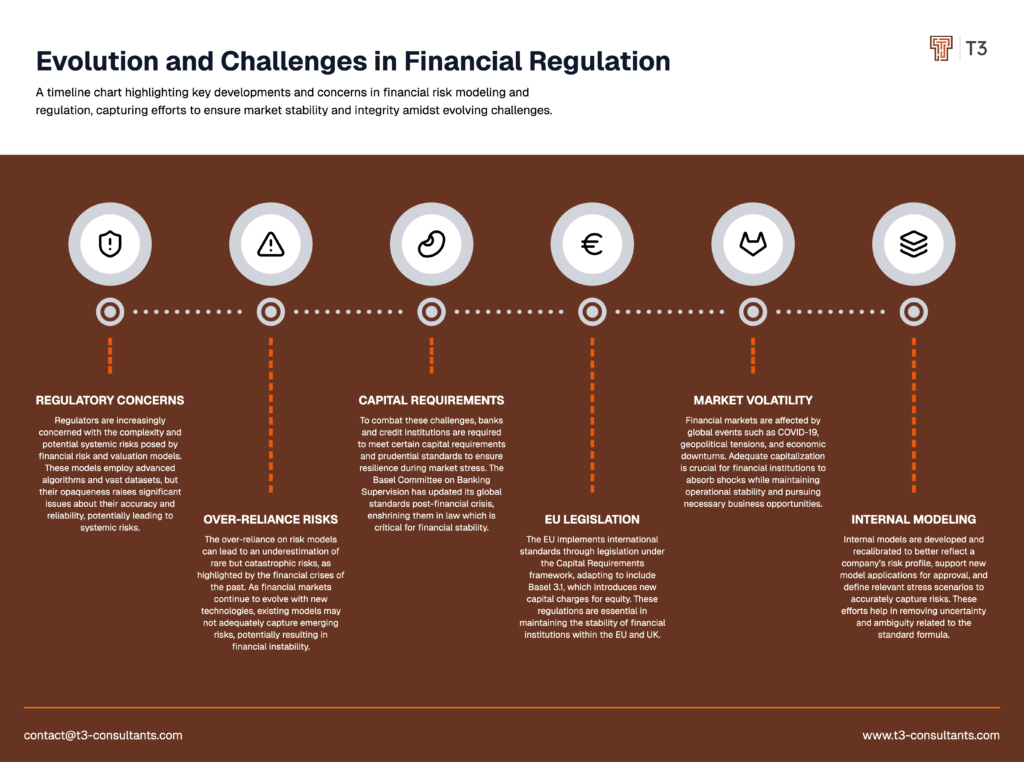Independent Review of Risk Management Framework
Risk ModelsModels & Measurements
Regulators are increasingly concerned with the use of risk and valuation models in finance due to their growing complexity and potential systemic risks. These models, often driven by advanced algorithms and vast datasets, can be opaque and difficult to oversee, raising concerns about their accuracy and reliability. There’s also the issue of over-reliance on these models, which can lead to underestimating rare but catastrophic risks, as exemplified by past financial crises. Additionally, as financial markets evolve with new technologies and instruments, regulators worry that existing models may not adequately capture emerging risks, potentially leading to financial instability and market distortions. This concern is intensified by the rapid pace of innovation in financial technologies, which might outstrip regulatory frameworks’ ability to adapt and ensure market integrity and consumer protection.
Overview of Topic
Banks and credit institutions, are required to meet certain capital requirements and other prudential standards in order to ensure their resilience, particularly during times of market stress. Following the financial crisis, the Basel Committee on Banking Supervision updated its global standards which then had to be enshrined in law by legislators and regulators. For EU member states, the implementation of these international standards on capital requirements comes through EU legislation under the various iterations of the Capital Requirements framework (the Directive CRD and the Regulation CRR). The next revision, Basel 3.1 has recently been agreed, it will introduce new capital charges for equity. These regulations are part of a broader effort to ensure financial stability within the EU and UK, and they continue to evolve to address emerging risks and challenges in the financial sector.

Significance in Today's Landscape
The financial markets have experienced significant volatility in recent years due to various global events such as the COVID-19 pandemic, geopolitical tensions, and economic downturns. Adequate capitalization helps financial institutions withstand market shocks and maintain stability, without having to forgo relevant business opportunities.
Internal model (full or partial) can provide a solution that not only better reflects the company’s risk profile, but again, removes some of the ambiguity and uncertainty related to using the standard formula. Internal Model support encompasses: developping and recalibrating models, supporting new model applications for approval and defining the relevant stress scenarios for companies to adequately capture their RWA exposures.
WHO DOES IT IMPACT?
All firms developing or implementig their own valuation and risk management capabilities
Asset Managers
Banks
Commodity House
Fintechs
How Can We Help?
T3 can help you with your model waiver and regulatory change management process.
The following steps can summarise it:
1
Regulatory Advisory
Our regulatory advisors can assist you in understanding the complex regulatory requirements of IM and running self-assessment to inform management on non-compliant and partially-compliant rules as well as support the definintion of relevant remediation plans.
2
Data Management
Our risk SMEs provide support in enhancing data quality, availability, and consistency to meet IM’s stringent data requirements as well as assist in developing robust data governance frameworks.
3
Model Development and Validation
Our Model Validation experts can you in developing, validating, and implementing new risk models as per IM guidelines. This could involve period or on-demand validation and back-testing of models to ensure they remain compliant.
4
Technology and Infrastructure
Upgrading existing systems in order to mplement new risks into firm infrastructure or transfer some non-modellable risks into modelable risks
5
Impact Assessment
Our quantitative analysists and technical risk consultants can support Quantitative Impact Studies (QIS) to assess the capital and business impact of IM. This includes a gap analysis to identify areas of non-compliance and potential improvements
6
Capital Optimization
Strategies to optimize capital allocation under new capital frameworks or when new products are added to the portfolio.
7
Training programs to educate staff on IM requirements and implications
Building awareness across the organization to ensure a cohesive approach to compliance.
8
Implementation Planning and Execution
Detailed implementation roadmaps and project management support to ensure timely compliance.
9
Testing and Validation
Support in conducting rigorous testing of all IM components to ensure accurate implementation.
Establishing a validation framework to continuously monitor compliance.
10
External Audit and Review
Engaging external auditors to review IM implementation and provide independent assurance.
Addressing any findings and recommendations from external reviews.
Want to hire
Regulation Expert?
Book a call with our experts
